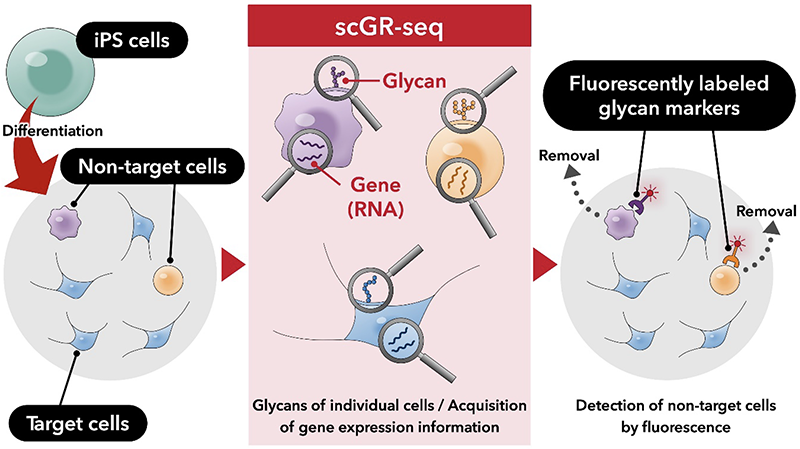―Developing Glycan Markers Capable of Labeling Non-Target Cells from iPS-Derived Neural Cell Populations―
Researchers) ODAKA Haruki, Senior Researcher, Cellular and Molecular Biotechnology Research Institute, TATENO Hiroaki, Attached to a Research Group, Cellular and Molecular Biotechnology Research Institute
- Using scGR-seq, a technique enabling simultaneous analysis of glycan and gene expression information, we revealed that non-target cells coexist within populations of iPS cell-derived neurons.
- Successfully developed a glycan marker capable of labeling non-target cells to facilitate their removal
- Contributes to advancing cell quality control and separation techniques in regenerative medicine

Development of Glycan Markers for Differentiated Cells Derived from iPS Cells Using scGR-seq Method
Researchers at AIST conducted a detailed analysis of glycans and gene expression information in neural cell populations differentiated from induced pluripotent stem (iPS) cells, identifying their diversity and the characteristics of highly expressed glycan antigens. They also successfully identified glycan markers capable of labeling non-target cells.
Cell populations differentiated from iPS cells for regenerative medicine applications contain various "non-target cells" alongside the target cells. These cells must be identified and removed, as they may impact therapeutic efficacy and safety. Markers that distinguish cell type and state, such as surface proteins or glycans, are useful for removing non-target cells. However, the types of non-target cells present vary depending on the target cell type and differentiation induction method, making it difficult to create a marker common to all. Consequently, there is a need for technology to identify the types of non-target cells specific to each cell manufacturing process and determine/find specific markers for each type.
Here, we performed a detailed analysis of the glycans and gene expression in a population of neural cells differentiated from iPS cells. We used a technology developed by AIST called the 'single-cell glycan-RNA sequencing method' (hereinafter referred to as the 'scGR-seq method'), which enables the simultaneous analysis of glycan and gene expression for each individual cell. As a result, we successfully identified the cell types of non-target cells present within the neural cell population and the glycan markers capable of labeling them. This achievement contributes to advancing quality control and separation techniques for iPS cell-derived cells, and it is expected to enhance the safety and efficacy of regenerative medicine.
Details of this technology were published in Stem Cell Reports on September 4, 2025 (Eastern Time).
iPS cells are special cells capable of differentiating into various cell types, and they are expected to be useful in regenerative medicine and the development of new drugs. For example, they can replace cells lost due to disease or injury. They can also be used to test the effects of drugs using a patient's own cells. However, cells generated by inducing differentiation from iPS cells often contain not only the desired therapeutic cells but also undifferentiated cells and cells that have differentiated into unintended lineages. If these non-target cells enter the body, they could potentially cause unexpected side effects or safety issues. Therefore, to safely use iPS cells in medicine, it is necessary to remove these non-target cells.
To identify and remove non-target cells, markers—such as proteins or glycans present on the cell surface—that serve as indicators for distinguishing cell type and state are crucial. Glycans attached to proteins and lipids inside and outside living cells are widely used as markers because they change depending on cell type and state. If markers specific to non-target cells can be identified, these cells can be detected and separated using techniques like flow cytometry, where they are labeled with fluorescent markers. However, the types of non-target cells that contaminate the cells vary depending on the type of target cells and the differentiation induction method used. This makes it difficult to develop markers that are universally applicable across all cases. Consequently, there has been a need for technology to identify the specific non-target cell types in each manufacturing process and find corresponding markers for them.
Journal: Stem Cell Reports
Paper Title: Single-cell glycome and transcriptome profiling uncovers the glycan signature of each cell subpopulation of human iPSC-derived neurons
Authors: Haruki Odaka, Hiroaki Tateno
DOI: 10.1016/j.stemcr.2025.102631